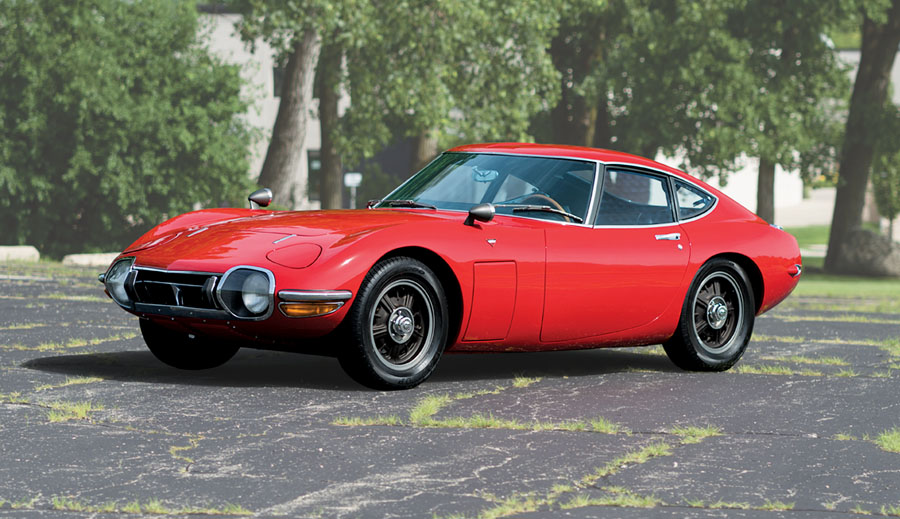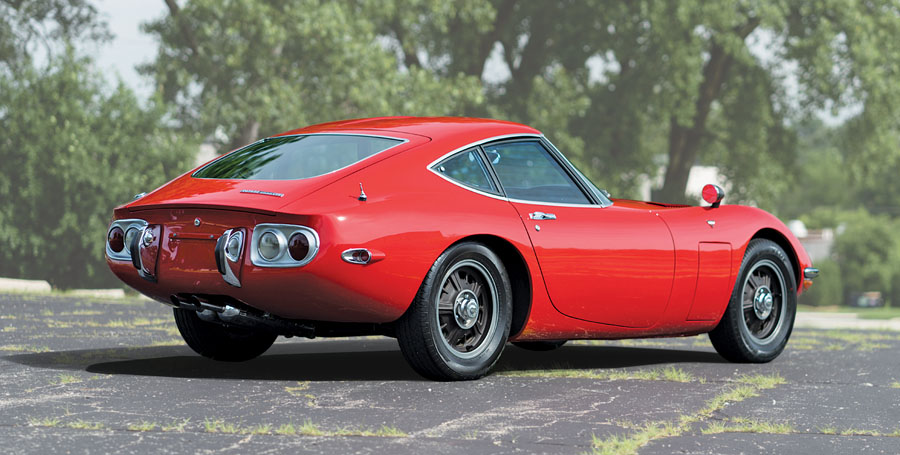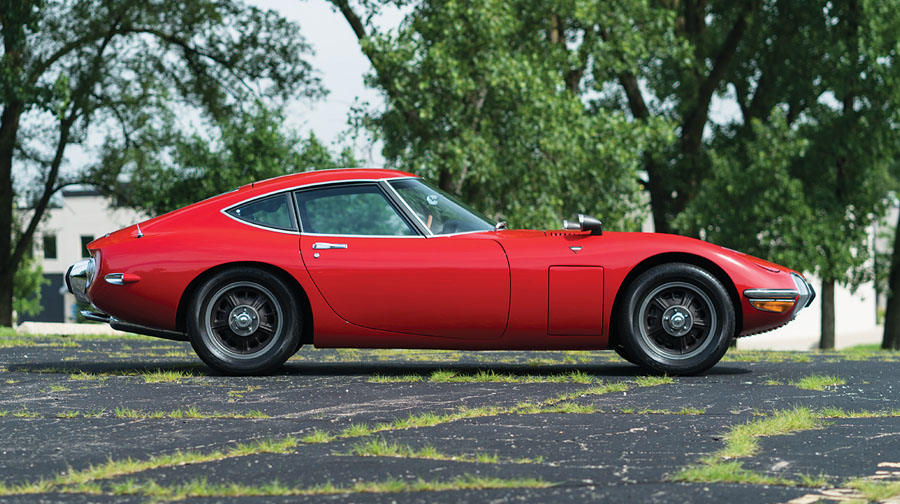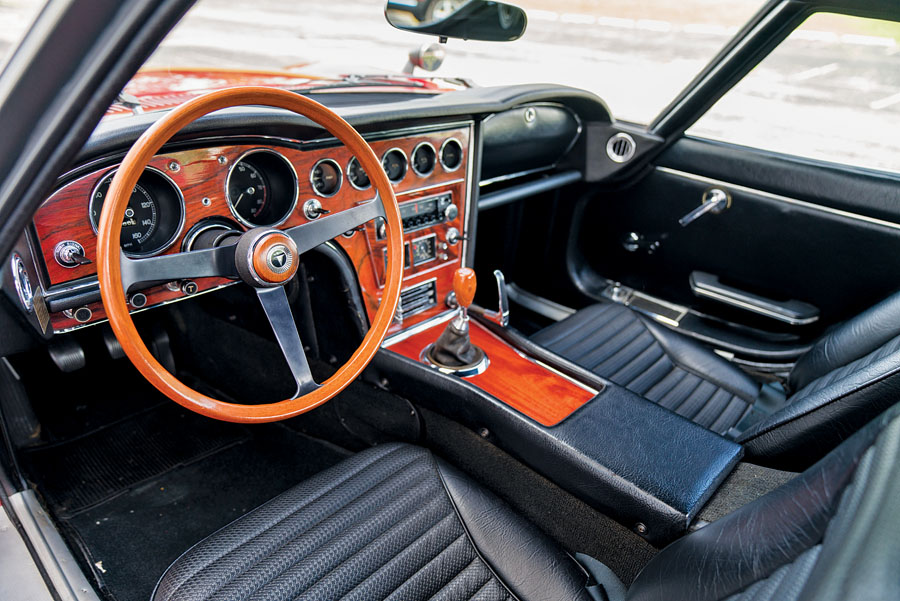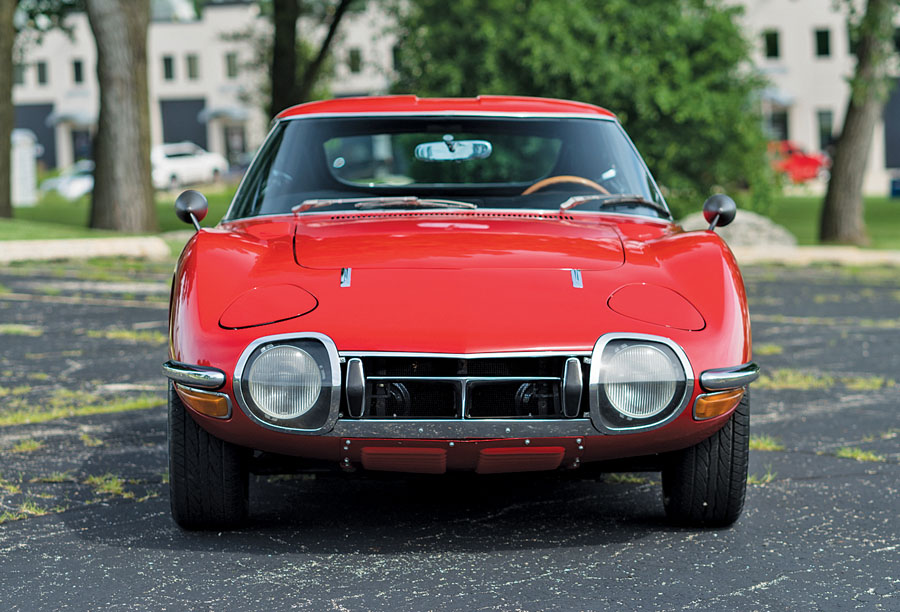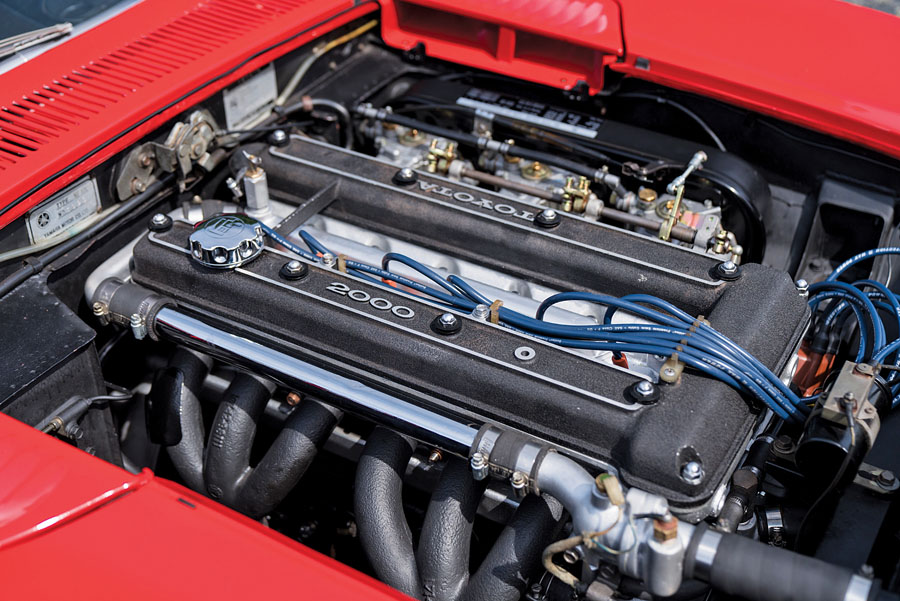SCM Analysis
Detailing
| Vehicle: | 1967 Toyota 2000GT |
| Years Produced: | 1967–70 |
| Number Produced: | 351 (75 LHD) |
| Original List Price: | $6,800 |
| SCM Valuation: | $825,000 |
| Tune Up Cost: | $575 |
| Chassis Number Location: | Engine bulkhead |
| Engine Number Location: | Bottom left side of block |
| Alternatives: | 1965–66 Lotus Elan 26R, 1965–69 Bizzarrini Strada, 1965–67 Alfa Romeo GTA |
| Investment Grade: | B |
This car, Lot 166, sold for $550,000, including buyer’s premium, at Gooding & Company’s Pebble Beach auction on August 25, 2018.
I’ve long admired the 2000GT — which, for me, is the ultimate Japanese car of the 1960s. I’ve previously written that I think the 2000GT suffers a bit from the BMW 507 syndrome: It’s a beautiful and interesting model that has almost no relationship to the rest of the marque’s contemporary offerings, and it had no development or follow-up. However, that hasn’t kept the 507 from becoming one of the most desired and valuable cars in the market.
A stunning leap
The sale of a Toyota 2000GT for $1m in 2013 set the market alight with wonder and seemed to clearly announce that Japanese cars had truly arrived as important collectibles, firmly in the “investment” class.
Of course, we have seen many cars that are rare and rarely seen in the public-sale market make what appears to be a stunning leap upwards when a superb example is presented at auction and captures the imagination of two potential owners.
What also often happens is that after such an event, other very good cars come out of hiding and sales frequently equal or come close to that record price. This was the pattern with the 2000GT — a cluster of sales near the million-dollar mark soon followed.
History also often shows, as seen recently with the Mercedes-Benz 190SL, that not every car can bring the interest that the record-setters do, and extravagant seller expectations can quickly run into a brick wall of potential buyer resistance.
I rarely tire of making comparisons between the world of fine art and cars when it comes to values, and I’ll do it again here. Just because a particular work by an artist brings a titanic price at auction, it does not necessarily follow that all that person’s oeuvre can command the same premium over other works. While emotion is a key factor in any transaction, it more often comes down to basic attributes of value and interest on the part of potential buyers.
So is this sale of a 2000GT for half the high-water mark a story of slipping values or one of the driving forces of collecting interest? Could it also be the particular situation of an individual car, or is it an indication that despite the apparent “arrival” of Japanese cars in the upper reaches of the collector-car arena, their place isn’t yet secure?
I would argue that all the above played a part in this result.
What do you do with it?
The first question I ask a client who comes to me for advice on purchasing a car is a simple one: What do you want to do with it? The answers can vary, and all are valid. Concours, rallies, vintage races, tours, casual weekend or cross-country drives and just gazing at it in your garage with a glass of wine in hand are all compelling motivations. Values almost always align with how and where a car might be used, the number of people who share that interest, and how many of them have the available funds.
So what do you do with a 2000GT? Owners find it a very entertaining driver, eminently suitable for long-distance vintage rallies such as the Copperstate 1000. But these cars are not often seen on entry lists.
Most concours would be happy to invite a well-presented example, as relatively few people in the world have actually seen one in person. There are no 2000GT club events akin to the Duesenberg, Ferrari 250 GTO or 300SL tours, and while the car was campaigned in SCCA events for a year, it’s not a vintage-race or track-day car.
Chassis MF1010100 was, by most opinions, one of the best examples of the model, with an excellent provenance, including ownership by Otto Linton. It has been well maintained, and in the hands of at least one previous owner, was used in both major display and rally events. Its history included the replacement of the original Mikuni-Solex carburetors with Webers, and other than a respray in the original Solar Red color, it remained a well-preserved original. I thought it looked sensational sitting in the preview and casually wondered what it might bring.
High-water marks for the 2000GT at auction were a pair of sales at $1,155,000 in August 2014 at Gooding & Company Pebble Beach and by RM Auctions in April 2013 at the Don Davis Collection sale. The Davis car, a Bellatrix Yellow example, had been sold privately in June 2010 with an asking price of $375,000.
The estimate on this car was $800k–$1m, which nicely covered its auction history from 2015 through 2017. It was last reported sold at the Mecum May 2017 Indianapolis sale for $825,000 (SCM# 6838833). Prior to that, it had appeared at Mecum Kissimmee, FL, in January 2017, not sold at a called high bid of $725,000 (SCM# 6824895); in August 2016 at Mecum’s Monterey, CA, auction, it was unsold at a called high bid of $700,000 (SCM# 6808890) and was reported as sold at Mecum Monterey in August 2015 for $1,017,500 (SCM# 6786189).
Cooled frenzy
Buyers in today’s market respond most strongly to cars fresh to the market. MF1010100 was, unfortunately, not that.
During its journey from storage to auction ramp and back again, it began to become clear that, for whatever reason, this was no longer a car that could hold the interest of an owner for an extended period, nor attract enough potential buyers to sustain its previous value.
This sale indicated market level on this date and also demonstrated that the owner felt the desire to let it go. It doesn’t necessarily reflect a halving in value of all 2000GTs, but does clearly show that any frenzy to own one of these cars at any cost, “before it’s too late,” has abated.
Regardless of the price realized, the positive attributes of the Toyota 2000GT remain. It’s attractive, rare, fun to use and an historic artifact. As such, enthusiasts who appreciate those traits will always find pleasure and satisfaction in ownership.
Whether or not we see sales of another car — perhaps more totally original or correctly and freshly restored — closer to the $1m mark, this new owner has certainly done well simply based on the attributes of the 2000GT.
(Note: A few days after I filed this story, chassis MF1010100 came up for sale again in early October on Bring a Trailer. The August buyer was a dealer who apparently saw “opportunity” in the buy. I’m sorry to report that the BaT auction no-sale at a bid of $550,000 appears to reinforce my conclusion about freshness to market. I wish the best for this car in the hands of an appreciative end user.) ♦
(Introductory description courtesy of Gooding & Company.)
